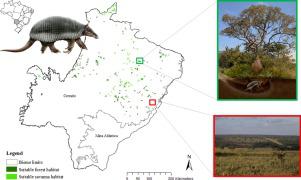Perspectives in Ecology and Conservation ( IF 4.0 ) Pub Date : 2021-02-12 , DOI: 10.1016/j.pecon.2021.01.001 Katia Maria Paschoaletto Micchi de Barros Ferraz , Bruna Gomes de Oliveira , Nina Attias , Arnaud Leonard Jean Desbiez

|
The potential distribution of a cryptic, naturally rare large mammal, the giant armadillo Priodontes maximus, was explored in fragments of Cerrado and Atlantic Forest in the state of Mato Grosso do Sul (259,641 km2) Brazil. Watersheds (N = 344) throughout the state were surveyed for evidence of the species with 164 confirmed presences and 180 absences. A total of 144 independent presence points were used to model the current potential distribution of the species using the Maxent algorithm with 30 possible explanatory variables. Suitable and unsuitable areas, average patch size of suitable habitats and conversion rate of habitat from 1985 to 2018 were also calculated. Results highlight the severe fragmentation level of the suitable areas left for the giant armadillos, with suitable habitat patches (forest and savanna) surrounded by an agricultural matrix. Furthermore, only four suitable patches are larger than 100 km2 (132.63 ± 32.04 km2). Due to the species low population growth rate it is possible that individuals recorded are part of declining or functionally extinct populations. Further studies on the density and population trends of giant armadillos within this fragmented landscape will be key to understanding the potential long-term persistence of giant armadillos in the degraded Cerrado of MS.
中文翻译:

物种分布模型揭示了巴西赛拉多巨型犰狳只剩下高度零散的合适斑块
一个神秘的,天然珍稀的大型哺乳动物的电位分布,巨型犰狳Priodontes鲆,在马托格罗索州塞拉多和大西洋森林的片段进行了探讨do Sul的(259641公里2) 巴西。调查了整个州的流域(N = 344),以确认该物种有164个已确认存在和180个不存在该物种的证据。使用Maxent算法使用总共144个独立的存在点来模拟物种的当前势能分布,其中包含30个可能的解释变量。还计算了1985年至2018年的合适和不合适区域,合适生境的平均斑块大小和生境转化率。结果突出表明,巨型犰狳的合适区域存在严重的破碎化程度,合适的生境斑块(森林和热带稀树草原)被农业基质包围。此外,只有四个合适的斑块大于100 km 2(132.63±32.04 km 2)。由于该物种的种群增长率低,记录的个体有可能是数量下降或功能已灭绝的种群的一部分。在这个零散的景观中,对巨型犰狳的密度和种群趋势的进一步研究,对于了解巨型犰狳在MS退化Cerrado中的潜在长期持久性至关重要。










































 京公网安备 11010802027423号
京公网安备 11010802027423号